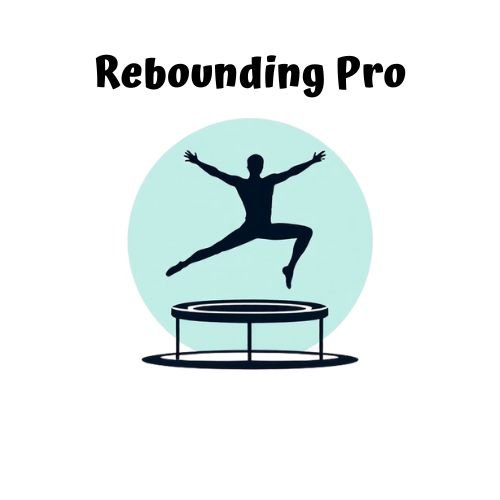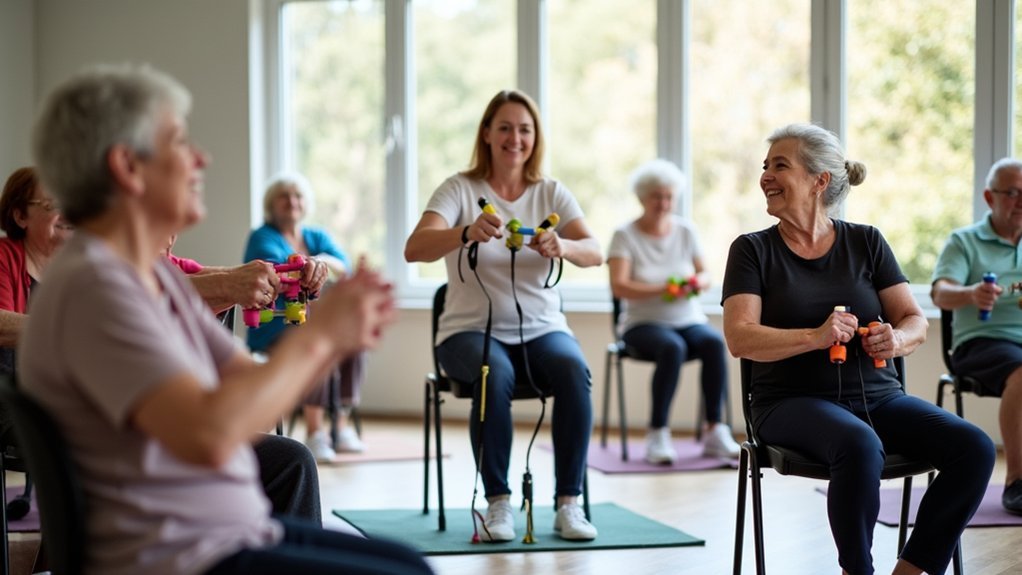Post-surgery exercise recovery begins with gentle movements like walking and breathing exercises within days after your procedure. You’ll gradually increase intensity as pain subsides and strength improves. Pre-surgery conditioning can greatly speed up your rehabilitation, while proper nutrition supports tissue repair. Expect to work closely with physical therapists who’ll create personalized plans targeting your specific needs. Recovery timelines vary, but most patients regain up to 80% of muscle mass within six months with consistent effort.
What To Expect During Post-Surgery Exercise Recovery?

Although the road to recovery after surgery varies for each patient, you’ll typically begin with gentle movements within days following your procedure. These initial exercises promote circulation and prevent stiffness as your body heals.
Walking will likely be your first recommended activity, enhancing blood flow and helping manage pain during post-surgery recovery. You’ll gradually increase both intensity and duration as your strength improves, focusing on low-impact activities to avoid strain on healing tissues.
Physical therapy often starts shortly after surgery, providing guidance on proper techniques and personalized exercise plans.
Throughout your recovery journey, remember to listen to your body—pain signals your limits. Don’t push through discomfort, as this could impede healing. Instead, let your pain levels guide your activity boundaries during this critical healing phase.
Pre-Surgery Physical Preparation: Building Strength for Recovery
While recovery follows surgery, preparation begins well before you enter the operating room. Pre-surgery physical preparation greatly impacts your healing journey, as stronger muscles better support recovering tissues and accelerate your return to normal activities.
Your pre-surgery exercise routine should include a mix of low-impact cardiovascular workouts, targeted strength training, and flexibility exercises—all tailored to your specific condition. These activities not only improve your mobility and endurance but also help manage weight and boost your immune system, reducing surgical risks.
Research shows that patients who consistently exercise before surgery typically experience less pain afterward and recover faster than those who don’t.
Even a few weeks of preparation can make a considerable difference, setting a foundation for a smoother rehabilitation process.
The First Days: Gentle Movement and Breathing Exercises

You’ll need to focus on gentle breathing exercises that stimulate circulation in those vital first post-operative days.
Try deep breaths that expand your lungs fully, followed by controlled exhalations to improve blood flow while you’re less mobile.
Complement these with modified movements like ankle pumps and assisted ROM exercises that won’t strain your surgical site but will keep your body active during early recovery.
Breathing For Circulation
During the initial days after surgery, breathing exercises serve as essential tools for jumpstarting circulation and preventing complications. You’ll need to practice deep breathing techniques—inhaling deeply and exhaling slowly—to expand your lung capacity and improve oxygen delivery throughout your body.
| Exercise Type | Benefit | Frequency |
|---|---|---|
| Deep Breathing | Expands lungs | Every hour |
| Diaphragmatic Breathing | Increases oxygenation | 5-10 times hourly |
| Pursed Lip Breathing | Controls air flow | When feeling short of breath |
| Incentive Spirometer | Measures lung capacity | 10 times per hour |
| Guided Breathing | Personalized technique | As directed by therapist |
Your therapist will customize breathing exercises to your specific needs. When combined with simple movements like ankle pumps, these techniques greatly reduce the risk of blood clots and support your body’s healing process, setting the foundation for more active rehabilitation phases later.
Modified Bed Movements
The first days after surgery demand careful attention to movement, even while you’re confined to bed.
Modified bed movements are essential for recovery after surgery, promoting circulation while protecting your healing tissues.
Your healthcare team will likely recommend these gentle exercises:
- Ankle pumps – Flex and point your feet several times each hour to prevent blood clots and maintain ankle mobility.
- Gentle knee bends – Slightly bend and straighten your knees while keeping your feet on the bed to preserve joint function.
- Supported leg raises – With your unaffected leg, perform small lifts while keeping the surgical area stable.
- Upper body shifts – Carefully change positions using your arms for support, relieving pressure points.
These movements complement your breathing exercises, enhancing circulation and preventing complications without compromising your surgical site.
Walking: Your First Step Back to Physical Activity
After your body has endured the stress of surgery, walking emerges as the ideal starting point for your return to physical activity. This accessible exercise requires no special equipment while promoting essential blood circulation that accelerates your healing process.
Begin with short, gentle walks, then gradually increase both distance and pace over the first 2-3 weeks. This measured progression prevents undue strain on your surgical site while safely rebuilding your mobility foundation.
You’ll likely notice that consistent walking helps manage both pain and fatigue during recovery.
As you maintain your walking routine, you’ll develop improved endurance that eases your shift back to daily activities. This low-impact movement is gentle on your joints while effectively preparing your body for more intense exercises later in your recovery journey.
Managing Pain Throughout Your Exercise Journey

While walking offers an excellent foundation for recovery, managing pain effectively becomes your next important focus. Pain signals can guide your rehabilitation journey when you understand how to interpret them.
You’ll need to develop strategies that balance activity with discomfort.
Here’s how to approach pain management during your exercise recovery:
- Distinguish between “good” discomfort and harmful pain – mild muscle fatigue is expected, but sharp or worsening pain means stop immediately.
- Apply ice after exercise to reduce inflammation and numb soreness.
- Incorporate heat therapy before gentle movements to increase blood flow and flexibility.
- Communicate regularly with your physical therapist about your pain levels so they can adjust your program accordingly.
Rebuilding Muscle Mass After Surgical Procedures
Rebuilding lost muscle mass represents one of the most essential aspects of your post-surgery recovery journey. Your body can regain up to 80% of pre-surgery muscle mass within six months when you follow a structured rehabilitation program.
Begin with gentle range of motion exercises and light resistance training during your early recovery phase. As healing progresses, gradually increase intensity under your physical therapist’s guidance. Resistance bands and bodyweight exercises effectively stimulate muscle growth without overwhelming healing tissues.
Consistency is key—maintain regular communication with your healthcare team about pain levels and progress. This dialogue guarantees you’re safely advancing your activities while optimizing muscle rebuilding.
Remember that rebuilding muscle mass is a progressive process that requires patience, but with proper rehabilitation techniques, you’ll steadily reclaim strength and functional capacity throughout your recovery.
Low-Impact Cardio Options for Post-Operative Patients
Restoring cardiovascular fitness plays an essential role alongside muscle rebuilding during your post-surgery recovery. Low-impact cardio options minimize joint strain while promoting healing and reducing complications.
You’ll benefit from these effective low-impact cardio options:
- Walking – Start with short sessions and gradually increase duration to improve circulation and mobility.
- Stationary cycling – Adjustable resistance lets you control intensity while supporting recovering joints.
- Swimming – Provides full-body conditioning with water’s natural resistance and buoyancy.
- Elliptical training – Combines upper and lower body movement with minimal impact.
These activities help manage pain and fatigue while rebuilding your endurance.
As you heal, you’ll notice improved stamina and strength, allowing for a safe shift back to more vigorous exercise routines.
Flexibility Training to Restore Range of Motion
As your body heals from surgery, flexibility training becomes a cornerstone of thorough recovery, helping you regain full range of motion and prevent long-term mobility limitations.
Working with a physical therapist, you’ll incorporate gentle stretching exercises tailored to your specific needs.
Research shows these targeted flexibility exercises can increase your range of motion by 20-30% within just weeks of surgery.
You’ll likely practice both passive and active stretching techniques to minimize scar tissue formation that could restrict movement.
Don’t underestimate the power of consistency—regular flexibility training that includes gentle rotations and stretches improves blood circulation to surgical sites, accelerating your healing process.
When to Progress: Advancing Your Exercise Intensity
You’ll know it’s time to increase your workout intensity when exercises no longer cause pain and you can complete them with relative ease.
Look for consistent improvements in your range of motion and reduced swelling as key indicators that your body is ready for more challenge.
Remember to progress gradually, perhaps by adding light resistance or increasing repetitions, but always prioritize pain-free movement over pushing your limits too quickly.
Signs of Readiness
Knowing when to advance your post-surgery exercise intensity requires attention to several key indicators from your body. Your recovery journey should progress systematically based on how your body responds to current activities.
You’re likely ready to increase your exercise intensity when:
- You can complete current exercises with minimal or no pain, indicating your healing tissues can handle greater demands.
- Basic movements like walking and stretching feel comfortable, showing foundational stability has returned.
- Your range of motion and strength have noticeably improved during physical therapy sessions.
- Post-exercise recovery periods aren’t marked by excessive fatigue or soreness.
Regular assessments with your physical therapist will help confirm these observations align with expected recovery milestones.
Listen to both your body’s signals and your healthcare provider’s guidance to guarantee safe advancement.
Pain-Free Movement First
The foundation of successful exercise progression after surgery rests on achieving pain-free movement. Your body communicates its readiness for increased intensity through comfort during basic activities.
Only advance to more challenging exercises when you can complete current movements without discomfort.
Use pain as your guide—it establishes the upper threshold for your activity level. Start with gentle, controlled movements that don’t trigger pain, then gradually introduce light resistance as your strength improves.
This methodical approach prevents setbacks and promotes sustainable recovery.
Stay in close communication with your physical therapist about any discomfort you experience during exercises. They’ll help you distinguish between normal muscle fatigue and concerning pain signals.
Working With Physical Therapists vs. Independent Exercise
After undergoing surgery, patients often face the crucial decision of whether to pursue recovery exercises under professional guidance or independently at home.
Working with a physical therapist offers significant advantages that can accelerate your healing journey.
- Personalized guidance guarantees exercises are performed safely, minimizing injury risks during this vulnerable recovery period.
- Tailored rehabilitation programs address your specific surgical outcomes and individual needs.
- Accountability and motivation from regular sessions help you maintain consistency that’s difficult to achieve alone.
- Real-time feedback allows for immediate adjustments to maximize recovery benefits.
While independent exercise can complement your therapy sessions by reinforcing learned skills, proceed cautiously without supervision.
Your physical therapist provides expertise that helps navigate the complexities of post-surgical recovery more effectively than self-directed approaches.
Nutrition Strategies to Support Post-Surgery Workouts
You’ll recover faster from surgery when you fuel your body with nutrient-rich healing foods that reduce inflammation and support tissue repair.
Timing your protein intake strategically throughout the day, particularly within the first hour after exercise, maximizes muscle recovery and prevents breakdown of healing tissues.
Your post-surgery workouts will become more effective when paired with a balanced nutritional approach that includes omega-3 fatty acids, vitamin C, and zinc-rich foods.
Nutrient-Rich Healing Foods
While your body undergoes the critical process of healing after surgery, proper nutrition becomes a powerful ally in your recovery journey. Incorporating nutrient-rich healing foods into your daily meals can greatly accelerate tissue repair and reduce inflammation.
Focus on these recovery-boosting options:
- Protein powerhouses – Include lean meats, fish, legumes, and dairy products to support tissue repair and rebuild muscles damaged during surgery.
- Vitamin C champions – Consume citrus fruits and leafy greens to enhance collagen formation and strengthen your immune response.
- Omega-3 sources – Add fatty fish, flaxseeds, and walnuts to your diet to combat inflammation and reduce post-surgical pain.
- Antioxidant-rich choices – Berries, nuts, and colorful vegetables fight oxidative stress and protect cells during healing.
Don’t forget to stay hydrated with 8-10 glasses of water daily.
Protein Timing Matters
Strategic timing of your protein intake plays an essential role in post-surgery exercise recovery, often making the difference between slow progress and ideal healing.
To maximize your recovery process, aim to consume 20-30 grams of protein within 30 minutes to 2 hours after your rehabilitation exercises. This critical window allows your body to utilize essential amino acids for tissue repair and muscle protein synthesis.
You’ll experience better results by pairing protein with carbohydrates, which helps replenish energy stores while enhancing recovery efficiency.
Don’t forget to stay hydrated while following this protein timing strategy—adequate fluid intake supports metabolic functions necessary for healing.
Mental Health Aspects of Physical Recovery
As your body heals from surgery, your mind undergoes its own recovery process that’s intimately connected to your physical rehabilitation.
Regular exercise during recovery isn’t just about rebuilding strength—it’s a powerful tool for maintaining your mental well-being.
Movement isn’t just physical medicine—it’s mental therapy during your healing journey.
When you participate in your physical recovery, you’ll experience:
- Natural mood enhancement through endorphin release during movement, combating post-surgical depression
- Increased sense of control over your healing journey, reducing feelings of helplessness
- Improved overall satisfaction with your recovery process when you’re actively engaged
- Reduced anxiety and isolation that often accompanies surgical recovery periods
If movement restrictions are causing frustration, talk with your healthcare team about modified exercises.
Regular communication about both your physical and emotional state guarantees you’ll receive thorough support throughout your healing journey.
Frequently Asked Questions
What Happens During Exercise Recovery?
During exercise recovery, your body repairs muscle tissue, replenishes energy stores, and removes waste products. You’ll experience decreased soreness, improved strength, and enhanced circulation as your systems restore balance after physical exertion.
How Do You Recover From Fitness After Surgery?
After surgery, you’ll need to start with gentle movements approved by your doctor. Gradually increase your activity level, listen to your body’s signals, and don’t rush the process. Follow your rehabilitation plan consistently.
What Is Considered Strenuous Activity After Surgery?
Strenuous activity after surgery includes high-impact exercises, heavy lifting, and movements that strain your surgical site. You’ll want to avoid intense sports, rapid twisting, and activities that cause pain until your doctor clears you.
Why Is Exercise Not Recommended After Surgery?
Exercise isn’t recommended after surgery because you’ll risk disrupting healing, increasing pain, and causing complications. Your body needs rest to recover, and premature activity can lead to re-injury or blood clots.
In Summary
You’re commencing on a challenging but rewarding recovery journey. Trust the process—your body needs time to heal. Listen to pain signals, follow your medical team’s guidance, and celebrate small victories. With patience and persistence, you’ll gradually reclaim your strength and mobility. Remember, recovery isn’t linear, but with proper nutrition, mental resilience, and appropriate exercise progression, you’ll get there.





Leave a Reply